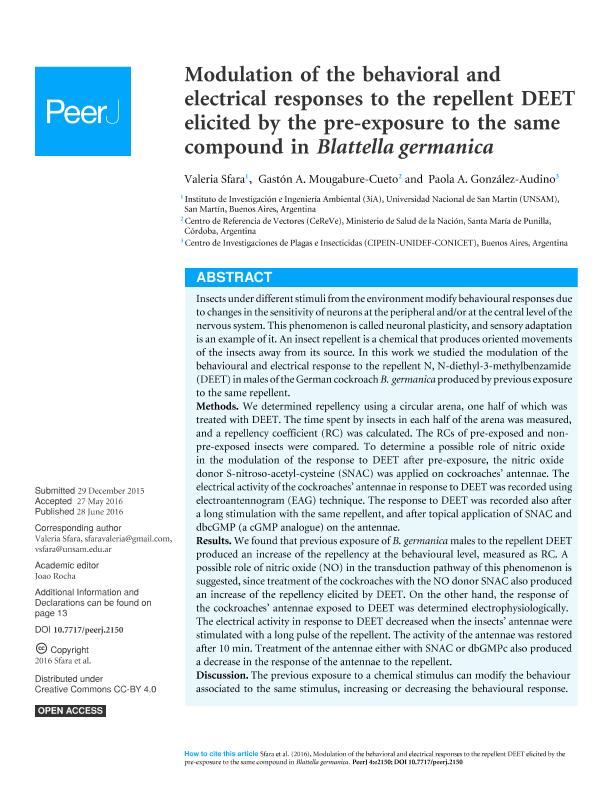Artículo
Modulation of the behavioral and electrical responses to the repellent DEET elicited by the pre-exposure to the same compound in Blattella germanica
Fecha de publicación:
06/2016
Editorial:
Peer J Inc
Revista:
Peer J
ISSN:
2167-8359
Idioma:
Inglés
Tipo de recurso:
Artículo publicado
Clasificación temática:
Resumen
Insects under different stimuli from the environment modify behavioural responses due to changes in the sensitivity of neurons at the peripheral and/or at the central level of the nervous system. This phenomenon is called neuronal plasticity, and sensory adaptation is an example of it. An insect repellent is a chemical that produces oriented movements of the insects away from its source. In this work we studied the modulation of the behavioural and electrical response to the repellent N, N-diethyl-3-methylbenzamide (DEET) in males of the German cockroach B. germanica produced by previous exposure to the same repellent.Methods. We determined repellency using a circular arena, one half of which was treated with DEET. The time spent by insects in each half of the arena was measured, and a repellency coefficient (RC) was calculated. The RCs of pre-exposed and non-pre-exposed insects were compared. To determine a possible role of nitric oxide in the modulation of the response to DEET after pre-exposure, the nitric oxide donor S-nitroso-acetyl-cysteine (SNAC) was applied on cockroaches antennae. The electrical activity of the cockroaches antennae in response to DEET was recorded using electroantennogram (EAG) technique. The response to DEET was recorded also after a long stimulation with the same repellent, and after topical application of SNAC and dbcGMP (a cGMP analogue) on the antennae.Results. We found that previous exposure of B. germanica males to the repellent DEET produced an increase of the repellency at the behavioural level, measured as RC. A possible role of nitric oxide (NO) in the transduction pathway of this phenomenon is suggested, since treatment of the cockroaches with the NO donor SNAC also produced an increase of the repellency elicited by DEET. On the other hand, the response of the cockroaches? antennae exposed to DEET was determined electrophysiologically. The electrical activity in response to DEET decreased when the insects antennae were stimulated with a long pulse of the repellent. The activity of the antennae was restored after 10 min. Treatment of the antennae either with SNAC or dbGMPc also produced a decrease in the response of the antennae to the repellent.Discussion.The previous exposure to a chemical stimulus can modify the behaviour associated to the same stimulus, increasing or decreasing the behavioural response. In the case of DEET we found that pre-exposure increased DEET repellency in male cockroaches. We also found NO involvement in a similar phenomenon. On the other hand, the test showed that DEET is perceived by insects antennae as an odour. A long exposure of the antennae to DEET caused a transient decrease in the response of the antennae to the same compound. The same effect was achieved by treating the antennae with SNAC or dbcGMP, suggesting the involvement of the NO/cGMP system in the transduction pathway of the sensory adaptation phenomenon elicited by an odour in this species.
Palabras clave:
ADAPTATION
,
BLATTELLA GERMANICA
,
DEET
,
REPELLENCY
Archivos asociados
Licencia
Identificadores
Colecciones
Articulos(CCT - CORDOBA)
Articulos de CTRO.CIENTIFICO TECNOL.CONICET - CORDOBA
Articulos de CTRO.CIENTIFICO TECNOL.CONICET - CORDOBA
Articulos(SEDE CENTRAL)
Articulos de SEDE CENTRAL
Articulos de SEDE CENTRAL
Articulos(UNIDEF)
Articulos de UNIDAD DE INVESTIGACION Y DESARROLLO ESTRATEGICOS PARA LA DEFENSA
Articulos de UNIDAD DE INVESTIGACION Y DESARROLLO ESTRATEGICOS PARA LA DEFENSA
Citación
Sfara, Valeria; Mougabure Cueto, Gastón Adolfo; Gonzalez Audino, Paola Andrea; Modulation of the behavioral and electrical responses to the repellent DEET elicited by the pre-exposure to the same compound in Blattella germanica; Peer J Inc; Peer J; 4; 6-2016; 1-16
Compartir
Altmétricas




